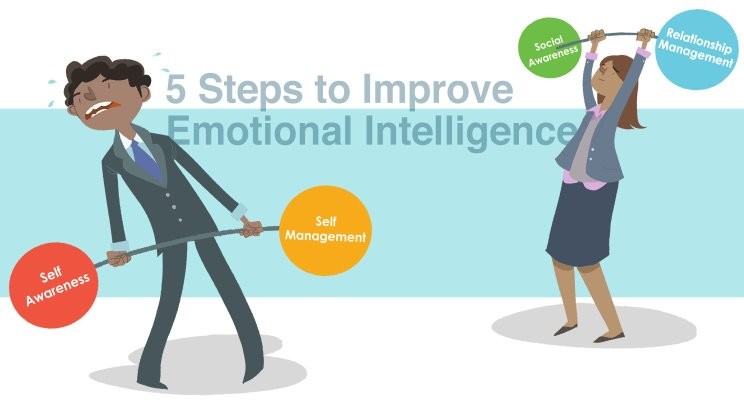
Five Steps to Develop Emotional Intelligence
When I give talks about the twelve emotional intelligence competencies, I'm often asked, "Can I get better at these competencies?"
The good news? Yes, you can improve them at any point in life. However, you need to use a different style of learning than what you used in school. To develop competency, you activate the part of the brain used for skill building, like getting better at golf or another sport. You need to have a good model, to practice, and to keep practicing.
Five Steps to Develop Emotional Intelligence Competencies
First, are you motivated? Do you really want to put in the time and effort? This matters because the brain’s emotional and social circuitry develops through the first 20 or 25 years of life. During that time, you developed habits and practiced them over and over. For example, perhaps you're not a good listener. You’ve practiced being a bad listener your whole life. To change that, first ask yourself, "Do I really care?"
Where do you want to be in five years? Will changing this help you get there? That's often very motivational. Richard Boyatzis, my colleague at Case Western University, helps his business school students improve by having them consider their vision for their life, and then work back from that vision to what can help them get there.
If you want to change, you can take the second step: get very honest feedback about your strengths and growth opportunities. Ask people whose opinions you trust, who know you well, for their input. It’s best to use a 360-degree instrument, a systematic assessment of how you act in this domain.
Richard Boyatzis and I co-designed with Korn Ferry Hay Group the Emotional and Social Competence Inventory. With the ESCI 360, you rate yourself on the twelve emotional intelligence competencies and other people rate you. You don't know who said what, but you get honest information about how others see you. Then, ask yourself, “Where would I improve the most if I could enhance one competency?” We recommend starting with one at a time.
The third step is to develop a learning plan and start practicing. If you want to become a better listener, the core of the empathy competency, your learning plan might be: whenever I have the opportunity to listen well, I'm going to put aside distractions, tech devices, other thoughts, and pay full attention to this person, listen to them fully. Then, I’ll say what I think they intended, and then say what I think.
That’s not easy. You’ve practiced being a poor listener for a lifetime. Try this. Cross your arms. It's comfortable. That's what a habit feels like. Now, cross your arms the other way, with the other arm on top. That feels a little strange. That's what it feels like at first to change a habit. You have to make an intentional effort. You need to be mindful of the opportunity to improve your listening. Follow the steps in your plan to be sure you're executing listening in a new, better way.
The fourth step is to have someone who can support you, who can help you think about how you can do it better next time. When we're under stress, time pressured, we tend to fall back on our habits. With a learning partner, coach, or support team, you can say “I was feeling time-pressed, couldn't bother listening. What could I do next time?” They can help you figure it out and see it as a learning opportunity, not a failure.
The final step is to practice at every naturally occurring opportunity. It may be at work, or at home, or somewhere else. Whenever there’s a chance to practice listening in a better way, you go through those steps. The more often you do it, the easier it gets. If you practice this way for three to six months, something will happen which is a neurological landmark. You'll perform the new habit, the basis of a better competence, as though it were second nature. You'll do it without having to think about it twice. That means the new way of doing it has become the preferred neurological pathway in your brain.
Do these steps work? Richard Boyatzis at Case Western has tracked people who have gone through this learning method. As much as seven years later, they still have the strength they developed, as reported by others with whom they now work.
Want to learn more about the twelve emotional intelligence competencies and how to develop them? In my new video series, Crucial Competence: Building Emotional and Social Leadership, I describe each of the competencies and discuss why they matter and how to develop them with Richard Boyatzis, Richard Davidson, Vanessa Druskat, and George Kohlrieser.
Process Automation East & South Europe & North East Africa Cluster VP presso Schneider Electric
5yinteresting , it is again about our motivation first, get a feedback, develop our Learning path, have some one coaching us and than ...PRACTISE ..
Curious, entrepreneurial, product, design, business and AI leader.
6yCaoilte Dunne
CEO at EQ Academy
7yGreat article! Worth a read.
Market Research Consultant
7yGreat article!
Profesora en area de la Musica y el Arte para el sector Privado, Difusora Cultural.
7yGracias , Muy bueno.